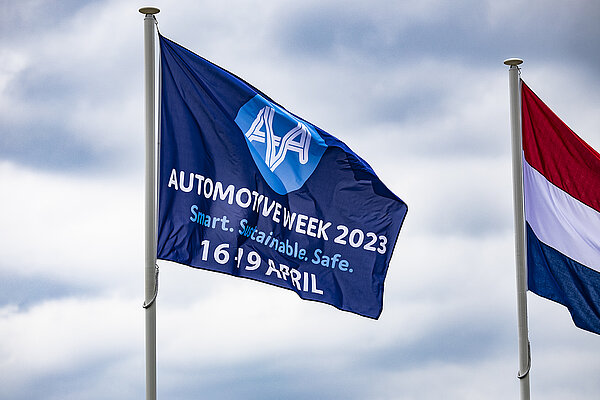Data Platforms for Mobility offer huge benefits for traffic users

Data platforms all around, each with its own specs and characteristics. But how can we make sure that they can talk to each other? How can we ensure interoperability between data platforms for mobility and logistics?
This article is written by Innovation Origins as part of a series about the Automotive Week 2023 that took place from April 16th to 19th at the Automotive Campus in Helmond.
Panelists at the Automotive Week
Shirish Kasa (Group Product Manager, TomTom)
Laurens Lapré (Vice President/Consulting Expert, CGI)
Menno Malta (CEO/Founder, Monotch)
Peter Verkoulen (Programma Manager Gaia-X, TNO)
Bard de Vries (Lead Architect, Nationaal Dataportaal Wegverkeer)
The big challenge, Bard de Vries says, is in the multitude of authorities, platforms, and other actors. “In the Netherlands alone, there are 350 road authorities: on top of the national authority, Rijkswaterstaat, there are the municipalities, provinces, and water boards. Then there are 42 different concessions for public transport. And to make it even more complicated, there are several vehicle-sharing concessions for bicycles and e-scooters. They all have their own data platform, of which the quality varies enormously. How can we ensure that these data hubs are of sufficient quality and support the multimodal travel use cases regarding geo coverage, timeliness, accuracy, suited for expected services, and interoperability across domains?” De Vries tries to connect the dots as an architect for the Nationaal Dataportaal Wegverkeer. “It needs to be safe, secure, and efficient. Embedded in the way we want to use public space: not only economically but also environmentally friendly and lively. And it must support EU legislation via the ITS directive.”

New actors
De Vries sees several developments that are influencing his efforts. “Next to all the authorities, we see a growing number of new actors. Think of vehicles and users as a sensor, the growing amount of historical data which can be processed through AI and machine learning, and the evolution from low latency to ultra-low latency. We need to treat all of that new data within the boundaries of GDPR and in an ethical and non-discriminatory way.” The only way to make this work, De Vries says, is by building ecosystems with partners who have a collaborative attitude and the awareness that they are dependent on each other to reach their goals.
Laurens Lapré (Smartwayz) elaborates on the benefits data platforms can offer truck drivers. The data is available abundantly. But how do we get it efficiently into the trucks? And how can we combine the data with static and dynamic traffic signs or dynamic road elements?” Together with eleven partners, Smartwayz can deliver the necessary data, even though it needs to consider the different levels of in-car integration. “Whether the driver is working with two devices, with one device and two apps, or with one device with a single solution, we know how to support them.”
The benefits are enormous, Lapré concludes.
“Fuel savings, fewer emissions, fewer accidents, a reduction of time, getting alerts, more accuracy, better planning, fewer traffic lights, and at the end of the day, better-informed drivers.”
Menno Malta, CEO of Monotch, explains why he founded his start-up. “Our TLEX platform - Traffic Live Exchange - solves what I always call the ‘smart mobility disease’. Most initiatives are purely technology focused, have a silo approach, forget to involve the audience and get stuck in pilots. With the result: there’s no real impact. That’s why we need a different approach, with real users and input from the complete ecosystem.” Use cases are now standardized, tested, and proven, Malta adds.

Overture Maps
Shirish Kasa (TomTom) also focuses on the need for collaboration throughout the ecosystem. “Working in silos results from not having the data from other sources and leads to lack of standardization.” TomTom tries to counter this with the Overture Maps Foundation, a collaboration with Microsoft, Amazon, Meta, and possibly new partners in the future. “Collaborative map building with a global entity reference system to simplify interpretability means we can go from separate maps to an integrated map platform with different layers. The interoperability is on three levels: process, attitude, and technology.”
Peter Verkoulen is responsible for the Dutch Gaia-X hub, which offers digital sovereignty and social and economic value through federated data and cloud infrastructures. “We want to go from a big tech lock-in to grip on data. The EU uses the carrots and sticks to get there: it gives support through investments and sets the rules through legislation like the Data Act.” Verkoulen stresses the importance of the Data Spaces Support Centre and the Dutch CoE-DSC platform, which aims to realize synergy potential and avoid fragmentation in data-sharing solutions. The CoE-DSC supports organizations in building use cases at scale to exploit value potential from data sharing and helps organizations to create required trust mechanisms to share data in a trusted and secure way.
“It’s all about interoperability, reusing knowledge, and an easy disclosure of data sharing expertise. We are building a one-stop-shop for data sharing challenges.”
Verkoulen
